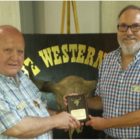Roundup: August 8, 2018
Our Speaker: Jeff Lapides, a member presenting for the first time since joining the Corral
His Subject: Passage to Eldoardo: The Pioneering Photographs of the Mojave Road by Rudolph d’Heureuse in 1863
GOLD! SILVER! And those seeking their fortunes—at a time of the Civil War, tense relations among white settlers, Hispanics and Native Americans, military exploits, salacious news accounts, greed—and one German immigrant with a camera.
Rudolph d’Heureuse—surveyor, cartographer, civil engineer, mining engineer, oenologist, inventor—who on one momentous journey photographed the Mojave Road in the Desert West from the waters of the Pacific Ocean to the banks of the Colorado River and the mines of Eldorado Canyon in today’s Nevada. His subjects included San Bernardino, Cajon Pass, and Los Angeles’s seaport, New San Pedro (Wilmington). He did it in 1863, many years before anyone else took the next photo of the desert, its environs, miners, travelers, forts, soldiers, watering holes, and crossroads.
Jeff Lapides is a photographer and a book designer for John W. Robinson and other historians. This Roundup presentation will be his first since he joined the Los Angeles Corral in 2016. Jeff is actively involved in the history communities in Sierra Madre, where he lives, and the San Gabriel Valley. Jeff is an award-winning book designer with over 25 years of graphic arts experience. Books that he designed have won several national design awards. He specializes in the preservation and promotion of history. You may find him on occasion at Lizzie’s Trail Inn, in good spirits, supporting the efforts of the Sierra Madre Historical Preservation Society.
Roundup Synopsis
Taken From Branding Iron 291 Summer 2018.
Tonight, our guest speaker was the Corral’s very own, “all-popular” Jeff Lapides, an award-winning book designer who has had over 25 years of extensive graphic arts experience. Jeff spoke of an astounding journey to what he calls “El Dorado.” Not the alleged gold haven in South America, but the mines in California that united the world in travel and excavation. On this night we heard about one man who would experience struggles and obstacles that only few could overcome. Rudolf D’Heureuse was born in Prussia in 1828 and came to adulthood in tumultuous times. Europe in 1848 caught that particularly French infection—revolution—and Prussia was not excepted. The turmoil caused Rudolf to escape on a ship and sail off west, first to London, and then finally to New York. There he heard news of a gold strike in California, and left New York to seek his fortune. He took the fastest and most treacherous route of the time, sailing via Panama. Before the construction of the famous canal, river boats could penetrate 70 miles into the interior, but the final 20 miles to the Pacific had to be crossed by foot through dense jungle. There, Rudolf picked up another ship going north to California. Upon arriving in San Francisco, he had little success in mining gold. After an exhaustive effort at gold mining, he returned to New York where he would later become a naturalized citizen in 1855. Rudolf made one more attempt at gold mining in California, which resulted in failure and bankruptcy. He briefly moved on to Canada, but the allure of California brought him back to San Francisco for a third and final time, where he finally struck pay dirt, but not in gold mining. While in Canada, Rudolf had dedicated himself to photography and architecture. This trade would lead him to acquire business in San Francisco when in 1862, venture capitalists approached him to survey the Colorado River. In this new assignment Rudolf excelled in capturing photos and creating maps of the Mojave Road from Los Angeles to the Colorado River. He took memorable snapshots such as the only known picture of a U.S. Camel Corps dromedary. Army bases were left vacant (save for one lone sentry each “holding the fort”) due to the ensuing Civil War. He also photographed a series of water holes such as Rock Spring, and the mining camp of Lewisville where crews had been segregated based on Northern or Southern loyalties in the “Great Unpleasantness.” At Lewisville, Rudolf practiced his cartographic skills by sketching very precise maps of the canyon and each miner’s claims. Rudolf would later find work in the California Geographical Survey. Finally, he returned to New York where he lived out the rest of his days. Rudolf died unmarried and childless. He remained largely unknown due to his decision to not commercialize his work. We are fortunate to learn of his work and see it well displayed in Jeff’s lecture. We could say this meeting was a “gold-mine” of intellectual nourishment!
— Jovanny Gochez



